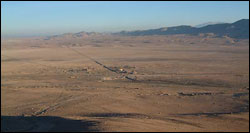This area deals with the fundamental laws and building blocks of nature and how they interact, the properties and the behavior of matter, and research into space and time and their structures.
innovations-report provides in-depth reports and articles on subjects such as astrophysics, laser technologies, nuclear, quantum, particle and solid-state physics, nanotechnologies, planetary research and findings (Mars, Venus) and developments related to the Hubble Telescope.

Scientists are fascinated by a dark, lake-like feature recently observed on Saturn’s moon Titan. NASA’s Cassini spacecraft captured a series of images showing a marking, darker than anything else around it. It is remarkably lake-like, with smooth, shore-like boundaries unlike any seen previously on Titan.
“I’d say this is definitely the best candidate we’ve seen so far for a liquid hydrocarbon lake on Titan,” said Dr. Alfred McEwen, Cassini imaging team member and

The dry, dusty, treeless expanse of Chile’s Atacama Desert is the most lifeless spot on the face of the Earth, and that’s why Alison Skelley and Richard Mathies joined a team of NASA scientists there earlier this month.
The University of California, Berkeley, scientists knew that if the Mars Organic Analyzer (MOA) they’d built could detect life in that crusty, arid land, then it would have a good chance some day of detecting life on the planet Mars.
In a place that ha

Astronomers at Australia’s national radio and optical observatories will watch as a probe released from a spacecraft slams into a comet about 133 million km away at a speed of nearly 37,000 km/h (10.2 km per second).
The cosmic demolition derby takes place about 4pm AEST on 4 July when the comet, Tempel 1, will be most easily seen from the mid-Pacific. The 370 kg probe, carried by NASA’s Deep Impact spacecraft, has been travelling toward the comet for 173 days and has

Recent research results by two physicists from the Niels Bohr Institute at University of Copenhagen, Thomas Heimburg and Andrew D. Jackson, cast doubt on the generally accepted theory of nerve activity. Their new theory of how nerves function emphasizes the essential role that temperature and pressure play in nerves. This result can contribute to a better understanding of the effect of drugs on nerve activity and will be published in the presitigous American journal Proceedings of the National Acad

The Six Parties of the International Thermonuclear Experimental Reactor (ITER) consortium have reached a decision in their negotiations, specifying the location of the world’s first energy-producing fusion reactor in Cadarache, in Southern France. The €10 billion project will generate multiple research opportunities for the Plasma Physics Research Centre at the Ecole Polytechnique Fédérale de Lausanne (EPFL).
ITER’s future location in Cadarache will be doubly beneficial to EPFL.

A research team from the Public University of Navarra has started a study of the design and development of absorbent materials that enable the storage of hydrogen, a clean fuel that can be used as an alternative to those derived from fossil fuels, such as petrol and diesel. The storage of this element is, in fact, a key process in the change over from internal combustion engines – contaminating and not very efficient, to cars with hydrogen fuel cells.
The project, entitled, De